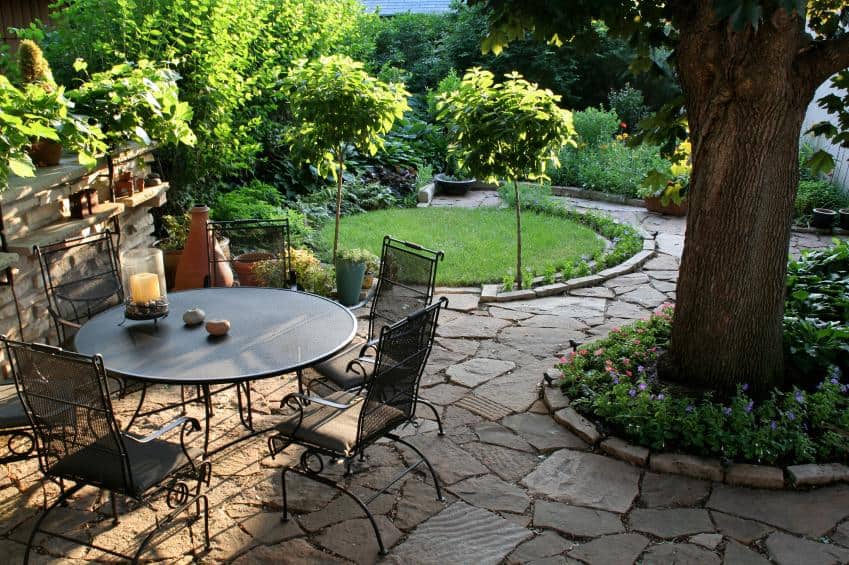If you want a garden that turns heads but won’t empty your wallet, do your own landscaping. It’s easy to familiarize yourself with the basic principles of landscaping design in order to create the yard of your dreams.
Follow our step-by-step guide to DIY landscaping on a budget. With these landscaping tips and ideas, and a few weekends’ worth of work, you’ll have all the curb appeal without all the expense.

1. Decide on a theme
When you begin your DIY landscaping project, you’ll first want to figure out the theme for your yard or garden. A theme will give you a blueprint from which to draw in terms of plants, hardscape and accessories.
A cutting garden, for instance, would contain plants ideal for bouquets, such as tea roses, cosmos, zinnias and tulips. Such gardens do especially well in raised beds, which you can easily and inexpensively build yourself using nontoxic materials. Knowing the theme of the garden also helps you pick out accessories. A cutting-style garden, for instance, is the perfect home for a gazing ball and arbor.
Theme gardens can illustrate a favorite storybook and include plants and accessories that play into the idea. Think Dr. Seuss or The Secret Garden. Get your children involved in the process, and create a theme that will grow with your family’s needs and wants.
2. Draw up plans
Like landscape designers do, draw up the plans for your garden on paper or on the computer. Doing so allows you to make a pleasing design and see when things aren’t fitting well or if you have empty holes to fill. When the design is still on paper, it’s easy to move things around and eliminate items if necessary.
Here is a list of free downloadable programs to get you started. Consider your water sources, habitual traffic patterns your family might use across the area, and necessities (like a grassy area for your dog). Add established trees and buildings, and take a look at the sun’s path over your property to allow proper growth of sun- or shade-loving plants. Think about the size of tools such as mowers or wheelbarrows that need to be moved around the garden area.
3. Create garden rooms
Just as the interior of the home has various rooms, such as living and dining rooms, entryways and kitchens, effective gardens contain the same elements. Look at your exterior in terms of rooms with various functions.
For instance, plan for an outdoor kitchen and dining area (i.e., your grill and your patio table), a living room area for sitting and chatting, and a lounge area with lounge chairs and hammocks where you can take an afternoon nap. Don’t forget the spot for the dog or the children to play.
Do you need a garden spot that could be gated off from the rest of the yard at times? Plan for a pretty gate or other moveable barriers. Do you need to protect your vegetable garden from deer or other animals? Factor in fencing, raised beds or a garden structure with a covering that lets rain and light in but keeps birds out. Perhaps you would like a private area for reading or meditating, free from the eyes of neighbors. Work these into your landscaping plans. Here are a few ideas to consider while planning your space.

Photo by Thirsty Turf Irrigation on Unsplash
4. Blend hardscape and plants
An eye-catching landscape does a good job of blending plants with hardscape items, such as pavers, retaining walls, barbecues, arbors and gazebos. You want a good mix of both types of items to create a yard that is functional and aesthetically pleasing.
Generally, hardscape items are put in first and then you plant around them. Add sculptural pieces for impact; they don’t have to be expensive. This Lowe’s video shows you how to cast your own concrete objects. Try these fun and easy DIY landscaping ideas to help you use inexpensive concrete mix to add personality to your garden. Use a variety of mosses and low-growing plants to accentuate a paved area, and find trailing plants for higher, geometric forms.
5. Consider mature plant size
Educate yourself about the eventual size of plants before including them in your landscape design. Some trees can reach 60 feet tall or be several feet wide, making them unsuitable for many home landscapes. Others drop leaves, seeds or cones at certain times of the year. Root systems could infiltrate sewer or water lines. Removing an overgrown tree can be costly, so make the right choice in the first place to save yourself money and headaches.
You can choose to plant perennial plants (plants that come back every year), annuals (you will have to replace them every year) or a blend of the two. Perennials such as lavender and daisy offer a reliable base, and annuals such as petunia or pansy allow you to change colors and flower types every year for a new and exciting look.
Garden stores often offer deals on multiple plant purchases, so don’t be afraid to ask for a discount if you are buying a cartload of plants. Talk to friends and family who have gardens, and ask them if they have any plants they have divided or removed. Also ask about cast-off plants or plants that have been neglected; you might be able to revive them with a good watering or a fresh pot of soil. Gardeners love to share the wealth of plants and flowers.
If you liked this post, you may also like:
- Add water wise rain gardens to your landscape
- Seed your spring garden indoors for less
- Conserve water, save money with a home garden xeriscape
- How to grow herbs and save money all year
- Grow lettuce and save money on salad
